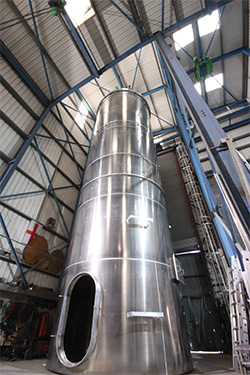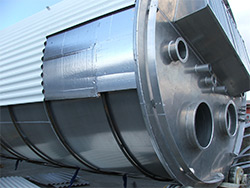Manufacturing of Aluminum & Stainless Steel Silos of Food Industry
Stainless Steel and Aluminium Pressure Vessels and Technical Silos for the Food Industries
There are a number of issues to consider when purchasing silos for the bulk storage of powdered foodstuffs and industrial compounds. These are listed below:
1) Storage Volume and Silo Shape
The storage capacity of a silo is primarily determined by its height and diameter; however consideration needs to be given to how the silo is filled and emptied. When powder is loaded into the top of a silo, it forms a cone. Therefore, additional free space called ullage or headspace is required to accommodate this cone. The space required is determined by the powder's flow characteristics. Barton will provide advice on necessary heights for this section during silo design.
At the bottom of the silo the outlet diameter and material flow characteristics of the powder determine the angle of the cone shaped outlet section. Barton' 30+ years design experience ensures the optimum angle is used for free flow of feedstock from the outlet. Having the correct silo cone angle together with appropriate discharge aids prevents 'dead zones' (where the material doesn't move) or bridging (where the material hangs in the silo).
The Barton Silo Capacity Calculator tool can be used to calculate an approximate silo storage capacity.

Silo assembly tower prevents contamination
It is essential that food storage vessels do not contaminate the stored product even during prolonged contact with the silo wall. Barton only use high quality stainless steel or aluminium and silos are manufactured inside a purpose built tower and fabricated using TIG welding to ensure welds are clean and contamination does not occur. In addition all silos are cleaned and sealed before delivery to avoid contamination during transit.
3) ATEX and Explosion Protection
Many powdered materials are explosive and foodstuffs are no exception, therefore, most powder storage silos in the UK must be designed to be ATEX compliant. At Barton, the silo itself is designed to withstand the high internal forces generated in the unlikely event that an explosion occurs. As part of design compliance, explosion vents are installed at the top of the silo to release the excess pressure in a controlled manner ensuring that both plant and personnel are protected.
For more information on ATEX compliant silos contact sales@bartonfabs.co.uk, or download the SHAPA Practical Guidance for Suppliers and Operators of Solids Handling Equipment for Potentially Explosive Dusts.

Twin walled construction with lagging reduces condensation
Ambient temperature changes can cause condensation. If this occurs inside the silo the foodstuff can be spoilt or clumping can occur preventing even discharge and leading to the need for additional routine cleaning. To reduce these problems Barton is able to produce double skinned silo walls with lagging in-between the walls. This type of silo construction is proven to reduce problems associated with condensation.

Silo load cell
Monitoring stock is an important part of inventory management and Barton silos can be supplied complete with load cells and remote telemetry systems. For more information contact sales@bartonfabs.co.uk.

Safe working environment within the Penthouse
Silos themselves are relatively maintenance free however units such as explosion vents, filling nozzles and dust collectors need routine checks and cleaning. For this reason Barton has created its Penthouse silo design. This includes an enclosure at the top of the silo to provide a safe working environment for maintenance activities.
Installations Include:
Adams Pork Products
Barry Callebaut
Birds Eye
Braces Bakery
British Bakeries
British Sugar Plc
Cadbury Plc
Cerestar UK Ltd
Diageo
Discovery Foods
GlaxoSmithKline
Greggs
Mars Confectionary
Meadow Foods
Mission Foods
Northern Foods Plc
Polarbröd
Reckitt Benckiser
RHM
Soreen
Warburtons
Weetabix